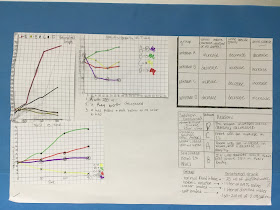This year I'm teaching Honors Biology at my school in addition to AP Biology. This is a brand new course and I've been given great freedom to design this class as I'd like. The only requirement was that the students are able to take and pass the Living Environment regents exam at the end of the year. My school also wanted me to come up with a name for the class since they didn't just want to call it Honors Bio. I thought about what I'd like students to do and in the end called it Analytical Biology. That proved to be a little intimidating, so we had to convince a few nervous students that it would be a doable class.
Recently in class, we have been working on the concept of water regulation. I wanted students to have practice analyzing how our excretory system handles the water and salt balance beyond just the required osmosis in onion cells required lab. I started a google search to see if there was anything out there appropriate for the class and came across this A&P lab by Cynthia Surmacz. The first part of the lab was beyond the scope of this class, but the end of the document included a dry lab. This dry lab provided students with data from an experiment that required students to analyze to determine which group drank which solutions.
I loved how this lab worked out for several reasons. The first was the graphing practice. Students were given data collected every 30 minutes from time 0 to 90 minutes. They had to graph specific gravity of urine, salt content, and volume. This lead to great discussions of how to decide the scale of a graph. We talked about the technique of determining the range of the data, then starting the y-axis at the lowest rounded value, putting the highest rounded value at the top of the graph and dividing the spaces in between evenly. This also lead to discussions of the goal of having your data fill at least 75% of the graph as opposed to squishing all of the data points in one-fourth of the graph.
I also loved hearing the students debating which group drank which solution. They had to make a table of which group drank which solution and support the decision with evidence. I think the students did fabulous thinking and it made the job that our kidneys do a little more real to the kids.
I separated out the dry lab part of the document and added instructions for my students, so they knew what I expected to be on their posters. Here is the link to that document.





No comments:
Post a Comment